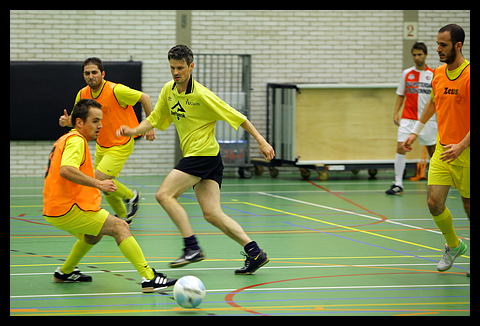Even leek het erop dat het uit vier TU-studenten bestaande estafetteteam van d’Elft/Wave écht geschiedenis had geschreven. Volgens de berichtgeving op NOS Teletekst had de Delftse zwemploeg zilver gewonnen op de viermaal 50 meter vrije slag op het NK sprint in Emmen.
In werkelijkheid viel hen een achtste plaats ten deel. Volgens Victor den Heijer “een prestatie waar we normaal gesproken alleen van kunnen dromen”. Na een voorzichtige start van de licht geblesseerde Mo Liems, zwommen Den Heijer, Jasper Barsingerhorn en Maarten van der Beek naar een gezamenlijke tijd van 1:38.03. Voor het eerst sinds 1999 eindigde hierdoor een Delfts studententeam in de nationale toptien van een nationaal (niet studenten-) kampioenschap.
Een ander prestigieus evenement van afgelopen weekend, niet in maar op het water, waren de roeiwedstrijden op de Bosbaan om de Koninklijke Holland Beker. Een belangrijk ijkpunt voor de (top)roeiers die in aanmerking komen voor de verschillende wereldbekerwedstrijden en WK’s.
De Holland Acht, met krachtroeier Olivier Siegelaar (Laga) op slag won goud. De nationale 4-, met zijn clubgenoot Meindert Klem aan boord, finishte met minimaal verschil voor runner-up Canada. Ook de 4M+, met Maarten van Blokland (Proteus) en de Lagaaiers Daan Heskes en stuurman Ryan den Drijver, sloot haar race over twee kilometer winnend af. Klem en Siegelaar maken op 8 juli tijdens de wereldbekerwedstrijd in Luzern deel uit van de Nederlandse equipe. Heskes en Van Blokland starten op het WK onder 23, eind juli in Amsterdam.
De nationale damesacht kwam zowel zaterdag als zondag in actie. In beide races bleven de Nederlandse vrouwen, met Sytske de Groot en Chantal Achterberg van Proteus, runner-up Canada met zo’n vier seconden verschil voor. Ook een andere zware opponent, Groot-Brittannië, hielden zij achter zich.
Een derde vrouw van Proteus uit de ruime selectie van de bondsacht, Ellen Hogerwerf, is niet geselecteerd voor Luzern. Wel start zij op het WK onder 23, in een twee-zonder. Proteeër Arnoud Greidanus kreeg te horen dat hij in Luzern in de lichte M4- mag roeien, samen met clubgenoot en vroegere roeipartner Roeland Lievens. Afgelopen weekend ging Greidanus in een lichte twee samen met Joeri Bruschinski (Vidar, Tilburg) over de baan. Hoewel de mannen nog maar twee weken samen roeien, bleken zij zich goed te kunnen meten met de internationale top. Ze eindigden op slechts 0.22 seconden van de Canadese LM2-.
Tips? Jimmy.tigges@hetnet.nl
Name: Shizhuo Liu (28)
Nationality: Chinese
Supervisor: Professor Ramon Hanssen (faculty of Aerospace Engineering)
Subject: Research on earth deformation using radar from satellites
Thesis defense: In one year and two months
“It took me several months as an MSc student to start understanding how synthetic aperture radar interferometry (Insar) works. This technique allows us to study the deformation of land surfaces by measuring the travelling time of microwaves sent from earth observation satellites. The first space-borne Insar mission operated by the European Space Agency (ESA) dates back to the early of 1990s. Before this mission, the only way to measure land deformation caused by human activities, like mining and groundwater extraction, was by ground levelling surveys, which cost considerable time, money and human resources.
I completed my BSc studies at Wuhan University, located in the middle of China, on the subject of geodesy (the scientific discipline devoted to determining the shape of the earth as precisely as possible). Six years ago I came to Delft for my MSc degree in aerospace engineering. The main reason for choosing the Netherlands is that it’s relatively cheap to do a Master’s here compared to other countries, like the United Kingdom. The fine reputation of the research conducted at the faculty is of course another important factor.
After my MSc I was offered a PhD position. The main goal of my PhD project is to mitigate the extra travelling time of microwaves caused by vapour in the atmosphere. This extra time can be very significant when the weather is cloudy and turbulent. In my research, I primarily use satellite images acquired by ESA’s ERS1/2 and Envisat satellites flying at an altitude of about 800 km and with a typical repeat orbit of 35 days. Currently, I’m working with images acquired over several years to try to filter out the atmospheric noise from the images.
From 2013 onwards, ESA will launch several new earth observation satellites to replace ESA1/2 and Envisat. One of the main advantages of the new generation satellites is the reduced repeat orbit of six days. This will allow us to filter out the noise much more quickly. And what’s more, it will also allow us to study irregular uplifts and declines in the Earth’s surface, which happen over short time spans, such as, for instance, during earthquakes. When you only receive images every 35 days, it’s sometimes difficult to say what has actually happened during that time span.
I like my project very much and am having lots of fun working with computer models. I like the logical way of thinking that I must adopt. I also think it will be useful to me in everything I do in life.



Comments are closed.